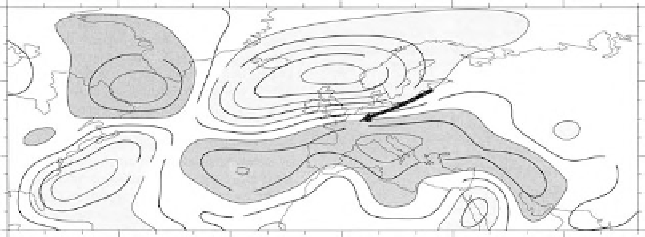Geoscience Reference
In-Depth Information
Figure 8.6 Schematic of
differences in precipitation
between the extremes of
positive and negative NAO.
H and L indicate areas where
high and low pressure
dominate. The arrow
represents cold dry NE
airflow in Europe during
strong negative NAO.
(Modified from Hurrell et al.
2003
: permission from
American Geophysical
Union)
(mm.day
-1
)
E-P
December-March
80
N
0.6
-1.2
-0.6
H
60
N
-0.6
0
0
0.6
0
40
N
0
0.6
-0.6
L
0
0.6
0
20
N
90
W
60
W
30
W
0
30
E
60
E
Between 1640 and 1659, drought occurred regularly in Eastern Europe, followed
by floods in the 1660s. The winters in England between 1659 and 1662 were
mild and dry, without snow.
The circulation variations reflected the dominance of the negative phase of the
NAO, especially in the second half of the century. The schematic in Figure
8.6
suggests that high pressure dominated the North Atlantic and extended over
northern Europe. Enhanced meridional circulation and blocking encouraged dry,
cold north to northeast winds in winter to extend over all of Europe (Wanner
et al.
1995
). Depression tracks and a much weaker westerly flow were shifted
well south, to the southern Mediterranean and North Africa. Luterbacher (
2001
)
summarizes the major pressure and circulation features for other seasons during
the 1675-1700 period. In spring, high pressure dominated Iceland and the area
north of 558 N latitude. To the south, the equivalent of the Icelandic Low shifted
toward Europe, creating unsettled, cold and snowy weather. In summer, wet and
cool westerlies in west and central Europe prevailed, originating from lows
which extended into the continent from further south than normal. In autumn,
high pressure occurred north of 608 N latitude, with southern Europe and the
Mediterranean under the influence of low pressure systems.
The changes in circulation strength leading to the extreme climate variations
progressed from west to east, associated with an expanded CPV, and changes in
length of the Rossby and standing waves in the mid-tropospheric westerlies
(Lamb
1977
; Bokwa et al.
2001
). Thus, the coldest period of the LIA began in
Britain about 1670, but did not reach Eastern Europe until about 1680.
As in the fourteenth century, the major reasons for the climate variations were
natural, despite human advances in industry and technology (Wanner et al.
1995
;
Luterbacher
2001
). The decrease in ocean temperatures in the North Atlantic
reduced themohaline circulation, and assisted the stability of the high pressure
systems, enhancing the negative NAO pattern. Sea ice was also extensive,
particularly between 1620 and 1640, and 1670 and 1700. This interrupted the
normal process of heat transfer from equator to poles. The Maunder Minimum

Search WWH ::

Custom Search